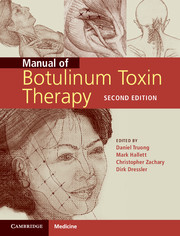Book contents
- Frontmatter
- Dedication
- Contents
- List of Contributors
- Preface
- Chapter 1 The pretherapeutic history of botulinum neurotoxin
- Chapter 2 Botulinum neurotoxin: history of clinical development
- Chapter 3 Pharmacology of botulinum neurotoxins
- Chapter 4 Immunological properties of botulinum neurotoxins
- Chapter 5 Treatment of cervical dystonia
- Chapter 6 Examination and treatment of complex cervical dystonia
- Chapter 7 Ultrasound guidance for botulinum neurotoxin therapy: cervical dystonia
- Chapter 8 Treatment of blepharospasm
- Chapter 9 Botulinum neurotoxin in oromandibular dystonia
- Chapter 10 Treatment of focal hand dystonia
- Chapter 11 Botulinum neurotoxin therapy of laryngeal muscle hyperactivity syndromes
- Chapter 12 The use of botulinum neurotoxin in otorhinolaryngology
- Chapter 13 Treatment of hemifacial spasm
- Chapter 14 Spasticity
- Chapter 15 The use of botulinum neurotoxin in spastic infantile cerebral palsy
- Chapter 16 The role of ultrasound for botulinum neurotoxin injection in childhood spasticity
- Chapter 17 The use of botulinum neurotoxin in spasticity using ultrasound guidance
- Chapter 18 The use of botulinum neurotoxin in tic disorders and essential hand and head tremor
- Chapter 19 Treatment of stiff-person syndrome with botulinum neurotoxin
- Chapter 20 Botulinum neurotoxin applications in ophthalmology
- Chapter 21 Cosmetic uses of botulinum neurotoxins
- Chapter 22 Hyperhidrosis
- Chapter 23 Botulinum neurotoxin A treatment for ischemic digits
- Chapter 24 Botulinum neurotoxin in wound healing
- Chapter 25 Use of botulinum neurotoxin in neuropathic pain
- Chapter 26 The use of botulinum neurotoxin in the management of headache disorders
- Chapter 27 The use of botulinum neurotoxin in musculoskeletal pain and arthritis
- Chapter 28 Treatment of plantar fasciitis with botulinum neurotoxins
- Chapter 29 Use of botulinum neurotoxin in the treatment of low-back pain
- Chapter 30 Use of botulinum neurotoxin in the treatment of piriformis syndrome
- Chapter 31 Ultrasound-guided botulinum neurotoxin injections for thoracic outlet syndrome
- Chapter 32 Botulinum neurotoxin in the gastrointestinal tract
- Chapter 33 Botulinum neurotoxin applications in urological disorders
- Index
- References
Chapter 2 - Botulinum neurotoxin: history of clinical development
Published online by Cambridge University Press: 05 February 2014
- Frontmatter
- Dedication
- Contents
- List of Contributors
- Preface
- Chapter 1 The pretherapeutic history of botulinum neurotoxin
- Chapter 2 Botulinum neurotoxin: history of clinical development
- Chapter 3 Pharmacology of botulinum neurotoxins
- Chapter 4 Immunological properties of botulinum neurotoxins
- Chapter 5 Treatment of cervical dystonia
- Chapter 6 Examination and treatment of complex cervical dystonia
- Chapter 7 Ultrasound guidance for botulinum neurotoxin therapy: cervical dystonia
- Chapter 8 Treatment of blepharospasm
- Chapter 9 Botulinum neurotoxin in oromandibular dystonia
- Chapter 10 Treatment of focal hand dystonia
- Chapter 11 Botulinum neurotoxin therapy of laryngeal muscle hyperactivity syndromes
- Chapter 12 The use of botulinum neurotoxin in otorhinolaryngology
- Chapter 13 Treatment of hemifacial spasm
- Chapter 14 Spasticity
- Chapter 15 The use of botulinum neurotoxin in spastic infantile cerebral palsy
- Chapter 16 The role of ultrasound for botulinum neurotoxin injection in childhood spasticity
- Chapter 17 The use of botulinum neurotoxin in spasticity using ultrasound guidance
- Chapter 18 The use of botulinum neurotoxin in tic disorders and essential hand and head tremor
- Chapter 19 Treatment of stiff-person syndrome with botulinum neurotoxin
- Chapter 20 Botulinum neurotoxin applications in ophthalmology
- Chapter 21 Cosmetic uses of botulinum neurotoxins
- Chapter 22 Hyperhidrosis
- Chapter 23 Botulinum neurotoxin A treatment for ischemic digits
- Chapter 24 Botulinum neurotoxin in wound healing
- Chapter 25 Use of botulinum neurotoxin in neuropathic pain
- Chapter 26 The use of botulinum neurotoxin in the management of headache disorders
- Chapter 27 The use of botulinum neurotoxin in musculoskeletal pain and arthritis
- Chapter 28 Treatment of plantar fasciitis with botulinum neurotoxins
- Chapter 29 Use of botulinum neurotoxin in the treatment of low-back pain
- Chapter 30 Use of botulinum neurotoxin in the treatment of piriformis syndrome
- Chapter 31 Ultrasound-guided botulinum neurotoxin injections for thoracic outlet syndrome
- Chapter 32 Botulinum neurotoxin in the gastrointestinal tract
- Chapter 33 Botulinum neurotoxin applications in urological disorders
- Index
- References
Summary
The clinical development of botulinum neurotoxin began in the late 1960s with the search for an alternative to surgical realignment of strabismus. At that time, surgery of the extraocular muscles was the primary treatment for strabismus, but it was unsatisfactory for some patients because of the variability in results, consequent high reoperation rates and its invasive nature. In an attempt to find an alternative, Alan B. Scott, an ophthalmologist from the Smith–Kettlewell Eye Research Institute in San Francisco, investigated the effects of different compounds injected locally into the extraocular muscles to chemically weaken them. The drugs tested initially proved unreliable, short acting or necrotizing (Scott et al., 1973).
About this time, Scott became aware of Daniel Drachman, a renowned neuroscientist at Johns Hopkins University and his work, in which he had been injecting minute amounts of botulinum neurotoxin directly into the hind limbs of chickens to achieve local denervation (Drachman, 1964). Drachman introduced Scott to Edward Schantz (1908–2005), who was producing purified botulinum neurotoxins for experimental use and generously making them available to the academic community. Schantz himself credits Vernon Brooks with the idea that botulinum neurotoxin might be used for weakening muscle (Schantz, 1994). Brooks worked on the mechanism of action of botulinum toxin for his PhD under the mentorship of Arnold Burgen, who suggested the project to him (Brooks, 2001). Schantz had left the US Army Chemical Corps at Fort Detrick, Maryland, in 1972 to work at the Department of Microbiology and Toxicology, University of Wisconsin in Madison. Using acid precipitation purification techniques worked out at Fort Detrick by Lamanna and Duff, Schantz was able to make purified botulinum toxins.
- Type
- Chapter
- Information
- Manual of Botulinum Toxin Therapy , pp. 8 - 11Publisher: Cambridge University PressPrint publication year: 2014
References
- 1
- Cited by



